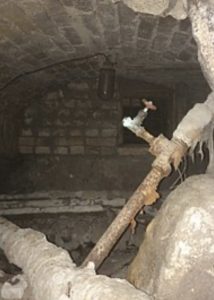Hitler
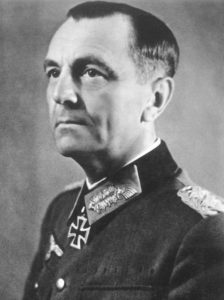
 As the Third Reich was losing its war against the world, German General Friedrich Paulus, who was commander in chief of the German 6th Army at Stalingrad, urgently requests permission from Adolf Hitler to surrender his position there. Paulus knew they had no chance, but Hitler refused. Of course, we all know that Hitler was insane. He would make his men fight to the death when there was no hope of winning the battle.
As the Third Reich was losing its war against the world, German General Friedrich Paulus, who was commander in chief of the German 6th Army at Stalingrad, urgently requests permission from Adolf Hitler to surrender his position there. Paulus knew they had no chance, but Hitler refused. Of course, we all know that Hitler was insane. He would make his men fight to the death when there was no hope of winning the battle.
Stalingrad was a prized strategic area, and the battle to take the city began in the summer of 1942. German forces assaulted the city, which was a major industrial center, but they had misjudged the Soviets. Despite repeated attempts and having pushed the Soviets almost to the Volga River in mid-October, as well as encircling Stalingrad, the 6th Army, under Paulus, and part of the 4th Panzer Army could not break past the adamantine defense of the Soviet 62nd Army. As their resources diminished. The Germans suffered diminishing resources, partisan guerilla attacks, and the cruelty of the Russian winter, all of which began to take their toll on the Germans. The Soviets made their move on November 19, launching a counteroffensive that began with a massive artillery bombardment of the German position. The assault began when the Soviets attacked the weakest link in the German force-inexperienced Romanian troops. Soviet soldiers took 65,000 soldiers prisoner that day. Then, the Soviets in a bold strategic move, encircled the enemy and launched pincer movements from north and south simultaneously, just as the Germans were encircling Stalingrad. It was at this point that the Germans should have withdrawn, and Paulus requested permission to withdraw, but Hitler wouldn’t allow it. He told his armies to hold out until they could be reinforced. Fresh troops would not arrive until December, and by then it was too late. The Soviet position was too strong, and the Germans were exhausted. They were out of options.
By January 24, the Soviets had overrun Paulus’ last airfield. His position was indefensible and surrender was the only hope for survival. Paulus urgently requested, “Let us surrender!!” Still, Hitler wouldn’t hear of it: “The 6th Army will hold its positions to the last man and the last round.” Paulus held out until January 31, when he finally surrendered. Of more than 280,000 men under Paulus’ command, half were already dead or dying, 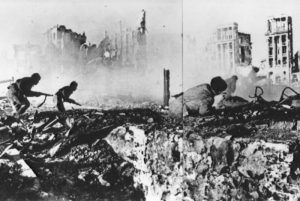
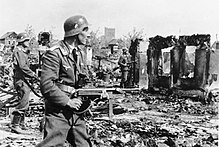 about 35,000 had been evacuated from the front, and the remaining 91,000 were hauled off to Soviet POW camps. Paulus eventually sold out to the Soviets altogether, joining the National Committee for Free Germany and urging German troops to surrender. Testifying at Nuremberg for the Soviets, he was released and spent the rest of his life in East Germany. Hitler was crazy, and his officers knew it, but there was little they could do about it.
about 35,000 had been evacuated from the front, and the remaining 91,000 were hauled off to Soviet POW camps. Paulus eventually sold out to the Soviets altogether, joining the National Committee for Free Germany and urging German troops to surrender. Testifying at Nuremberg for the Soviets, he was released and spent the rest of his life in East Germany. Hitler was crazy, and his officers knew it, but there was little they could do about it.
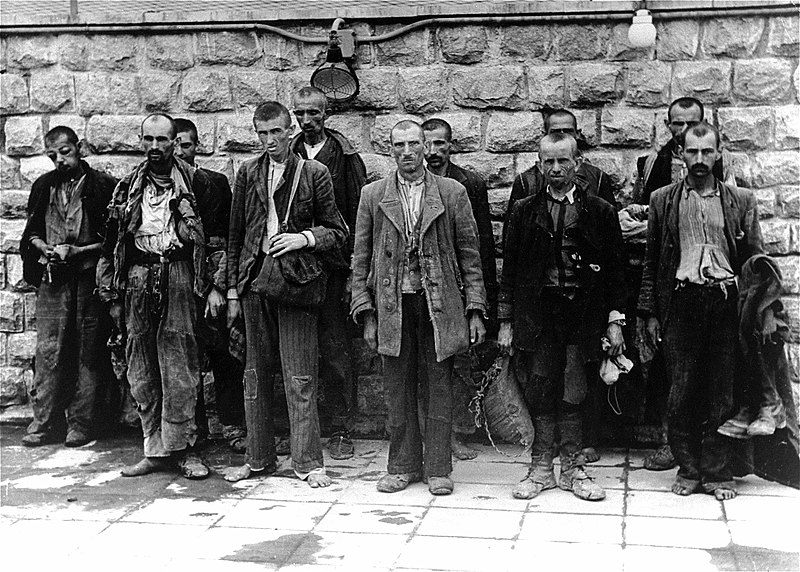 The atrocities the Nazis put the Jewish people and other minorities through in the camps, is well known to be horrible, but many people don’t know the half of it. Hitler had a number of camps in which to imprison these people that he had decided were “undesirable” for one reason or another. Some were even German people, who disagreed with Hitler’s ideas. They became the political prisoners. They were treated no better than their minority counterparts. Disagreeing with Hitler was a fatal choice for the most part.
The atrocities the Nazis put the Jewish people and other minorities through in the camps, is well known to be horrible, but many people don’t know the half of it. Hitler had a number of camps in which to imprison these people that he had decided were “undesirable” for one reason or another. Some were even German people, who disagreed with Hitler’s ideas. They became the political prisoners. They were treated no better than their minority counterparts. Disagreeing with Hitler was a fatal choice for the most part.
Mauthausen was the main political concentration camp in Austria. Mauthausen was not an extermination camp like Auschwitz-Birkenau. Nevertheless, it is estimated that about 100,000 people died at Mauthausen between its inception in 1939 and May 5, 1945, when it became the last camp liberated by the Allies. Sadly, like most of the camps, the liberation came just hours or days too late for some of the prisoners. These unfortunate ones died just prior to the liberation. Their strength gave out, just when rescue was so close.
Mauthausen was a little bit different than the other camps. Probably the greatest difference was the fact that the camp was in close proximity to a rock quarry. Near the quarry was a set of rock stairs known as the Stairs of Death. Most of us couldn’t imagine how a set of stairs could be considered such an instrument of death, that  they would become infamous, but that is exactly what these stairs did, and it is shocking. One of the survivors of Mauthausen gave this account saying, “Inmates were given light clothing and wooden (clogs) and put to work in the stone quarry. This involved carrying heavy stones up 180 steps, known as the “staircase of death” because of the beatings, shootings and fatal accidents to which the crowded mass of inmates was exposed to there. The food was totally inadequate for the heavy labor performed, and a stay in Mauthausen was indeed synonymous with “extermination by work.”
they would become infamous, but that is exactly what these stairs did, and it is shocking. One of the survivors of Mauthausen gave this account saying, “Inmates were given light clothing and wooden (clogs) and put to work in the stone quarry. This involved carrying heavy stones up 180 steps, known as the “staircase of death” because of the beatings, shootings and fatal accidents to which the crowded mass of inmates was exposed to there. The food was totally inadequate for the heavy labor performed, and a stay in Mauthausen was indeed synonymous with “extermination by work.”
Apparently, climbing the stone steps carrying heave stones was not the normal work performed at Mauthausen, but rather a deliberate punishment and death. The unfortunate prisoner or group of prisoners who made the guards angry, found out just how horrific this particular punishment was. One of the most famous incidents involved 47 Allied aviators transported to the camp. These men were essentially murdered in September 1944. Maurice Lampe, a French political prisoner, testified at Nuremberg saying, “For all the prisoners at Mauthausen, the murder of these men has remained in their minds like a scene from Dante’s Inferno. This is how it was done: at the bottom of the steps they loaded stones on the backs of these poor men and they had to carry 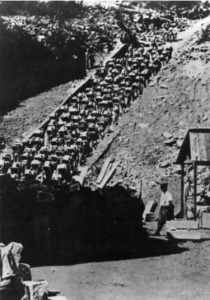 them to the top. The first journey was made with stones weighing 25 to 30 kilos (55 to 65 pounds) and was accompanied by blows. Then they were made to run down. For the second journey, the stones were even heavier; and whenever the poor wretches sank under their burden, they were kicked and hit with a bludgeon. Even stones were hurled at them… In the evening when I returned from the gang with which I was then working, the road which led to the camp was a bath of blood… I almost stepped on the lower jaw of a man. Twenty-one bodies were strewn along the road. Twenty-one had died on the first day. The twenty-six others died the following morning…”
them to the top. The first journey was made with stones weighing 25 to 30 kilos (55 to 65 pounds) and was accompanied by blows. Then they were made to run down. For the second journey, the stones were even heavier; and whenever the poor wretches sank under their burden, they were kicked and hit with a bludgeon. Even stones were hurled at them… In the evening when I returned from the gang with which I was then working, the road which led to the camp was a bath of blood… I almost stepped on the lower jaw of a man. Twenty-one bodies were strewn along the road. Twenty-one had died on the first day. The twenty-six others died the following morning…”
The sight of it was enough to make the description difficult for a man who had seen his share of horrific scenes in his lifetime. Anyone who had been in the camps, or through the camp, or involved in liberating the camps knew first hand the viciousness of the Nazi regime. Once they witnessed these atrocities, they could never forget what they saw. It was a scene that shaped them for the rest of their lives.
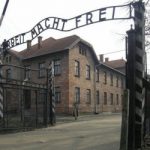
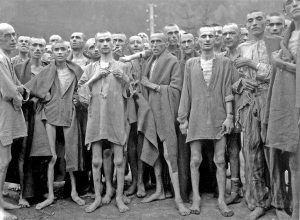 I read an article recently, that I can’t get out of my head. “A Study Finds 66% Of US Millennials Can’t Identify What Auschwitz Is” talks about the movement to remove certain elements from world history. The picture of Auschwitz is as foreign to kids these days as the idea of “The Final Solution” was prior to Hitler’s reign of terror in Germany and parts of Europe which led to the Holocaust. The thing that shocks me most is that when they were asked, after a tour of Auschwitz, which is located in Poland, why they didn’t tear these horrible buildings down, they responded, “Oh no!! We leave them up so that we will never forget what happened here, and never allow it to happen again.” Wise words, and words that more people would do well to remember today.
I read an article recently, that I can’t get out of my head. “A Study Finds 66% Of US Millennials Can’t Identify What Auschwitz Is” talks about the movement to remove certain elements from world history. The picture of Auschwitz is as foreign to kids these days as the idea of “The Final Solution” was prior to Hitler’s reign of terror in Germany and parts of Europe which led to the Holocaust. The thing that shocks me most is that when they were asked, after a tour of Auschwitz, which is located in Poland, why they didn’t tear these horrible buildings down, they responded, “Oh no!! We leave them up so that we will never forget what happened here, and never allow it to happen again.” Wise words, and words that more people would do well to remember today.
During the past year, we have seen unrest, protests, riots, and the “cancel culture” that has become almost the norm of our time. The schools don’t teach parts of history anymore, in an act of Historical Negationism or denialism. This is not about revising history based on new information that would correct history. Usually, the purpose of historical negation is to achieve a national, political aim, by transferring war-guilt, demonizing an enemy, providing an illusion of victory, or preserving a friendship. Sometimes the purpose of a revised history is to sell more books or to attract attention with a newspaper headline. The historian James M. McPherson said that negationists would want revisionist history understood as, “a consciously-falsified or distorted interpretation of the past to serve partisan or ideological purposes in the present” All of that sounds an awful lot like what we have going on today.
Couple Historical Negationism with “taking offence” or “political correctness” and you have a recipe for disaster. In many of the riots of recent days, the rioters have torn down our historical statues. To me, it doesn’t matter if they think the statue portrays someone they find offensive, or not. That person is a pert of history, good, bad, or ugly. A hero of the South, might not be a hero of the North, but to those in the South he or she might have been. Was a war hero from Germany any less a war hero to his countrymen, simply because he was forced to fight on the side of the Nazis? I don’t think so. In fact many of the German soldiers had no idea of what was happening in their own country. I’m not standing up for the rightness, nor against the wrongness of the people 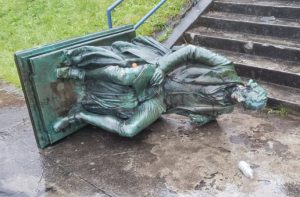
 portrayed in the statues, but rather against the destruction of property. The buildings destroyed in the riots, the statues destroyed by the mobs, the looting that took place, all deemed “okay” because these places had insurance…does not make these vicious acts acceptable, or their perpetrators blameless. It’s time that we teach our children about patriotism, respect, fairness, and decency. If we don’t, we are going to find ourselves in the middle of a country that is destroyed by violence and hate. Wake up America!!
portrayed in the statues, but rather against the destruction of property. The buildings destroyed in the riots, the statues destroyed by the mobs, the looting that took place, all deemed “okay” because these places had insurance…does not make these vicious acts acceptable, or their perpetrators blameless. It’s time that we teach our children about patriotism, respect, fairness, and decency. If we don’t, we are going to find ourselves in the middle of a country that is destroyed by violence and hate. Wake up America!!
 I am always amazed at the lengths nations will go to try to have a better weapon with which to war against their enemies. Some of the weapons were horrifically great successes, while others only succeeded in being amusingly unsuccessful. It seems that the Germans were famous for trying to come up with unusual ideas for weaponry. In fact, World War II seemed to be full of bizarre weapons.
I am always amazed at the lengths nations will go to try to have a better weapon with which to war against their enemies. Some of the weapons were horrifically great successes, while others only succeeded in being amusingly unsuccessful. It seems that the Germans were famous for trying to come up with unusual ideas for weaponry. In fact, World War II seemed to be full of bizarre weapons.
Wars always present opportunities for technological development, but Germany seemed to be particularly motivated to pour considerable resources into weapons projects. The level of success, varied with the weapons. That is not unusual, as weapons go, but I think that when you look some of the bizarre weapon designs that Germany came up with really seemed like a recipe for calamity to me. The weapons they came up with had varying degrees of success. The Germans developed the V-2 rocket, which both rained destruction on the United Kingdom and jumpstarted the space race. On the other hand, they also tried to build a “sun gun,” an orbital heat ray that was supposed to use reflected sunlight to torch cities.
The V-3 cannon project falls in the middle of the spectrum of weaponry. In the end, it never threatened the Allied powers, but if it had been given more production time, it very well could have. The V-3 was an extremely long artillery piece, over 430 feet in length. It was designed to fire projectiles up to a distance of 100 miles away. The V-3 cannon was built to bombard British cities from mainland Europe, bypassing the need for planes or the V-2. These enormous guns had been in development since World War I, on both sides of the conflict, but to this point these weapons hadn’t been deployed in combat. The problem was that the size of an explosion needed to propel a projectile over such a distance was so large that it would quickly destroy any gun barrel. They just couldn’t get that part fixed.
At the outbreak of World War II, the Germans rediscovered the plans for the V-3 and began to research them 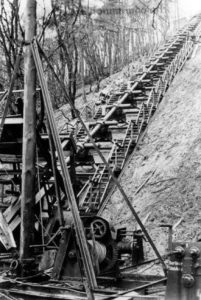 again. In 1943, Hitler restarted the V-3 project under his Armaments and War Procurement Minister, Albert Speer. The first goal was to solve the explosion problem. It was decided that the V-3 would use several small explosions that would propel the projectile along the barrel. Even with that change, the barrel was so large and unwieldy that it couldn’t be aimed. It had to be built already aiming at the intended target, and the target had to be the size of a city. That is a tall order.
again. In 1943, Hitler restarted the V-3 project under his Armaments and War Procurement Minister, Albert Speer. The first goal was to solve the explosion problem. It was decided that the V-3 would use several small explosions that would propel the projectile along the barrel. Even with that change, the barrel was so large and unwieldy that it couldn’t be aimed. It had to be built already aiming at the intended target, and the target had to be the size of a city. That is a tall order.
The Germans made plans to build 50 V-3 cannons on the French coastline, but RAF bombings delayed the project. When the Allies retook France in 1944, the V-3 project was again abandoned. The Allies didn’t learn of the V-3 project until after World War II had ended. Winston Churchill said that “if the guns had been completed, they could have devastated England more than any other German weapon.” Thankfully the Allies retook France in time to avoid such a disaster.
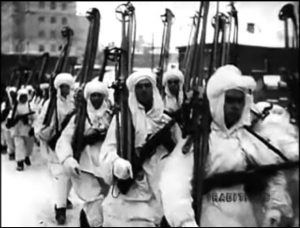 As a part of his planned world takeover, Hitler had sent his forces to invade the Soviet Union in June 1941. Early on it had become one relentless push inside Russian territory, but the Nazis experienced their first setback in August, when the Soviet Army’s tanks drove the Germans back from the Yelnya salient. A shocked Adolf Hitler told General Bock at the time, “Had I known they had as many tanks as that, I’d have thought twice before invading.” Personally, I doubt that it would have made any difference. Hitler did not particularly care about the lives of his men, just that they perform as they were ordered. For the men, there was no turning back because Hitler would not be moved. Hitler firmly believed that he was destined and well able to succeed in dominating the Soviet Union and capturing Moscow, where others had failed.
As a part of his planned world takeover, Hitler had sent his forces to invade the Soviet Union in June 1941. Early on it had become one relentless push inside Russian territory, but the Nazis experienced their first setback in August, when the Soviet Army’s tanks drove the Germans back from the Yelnya salient. A shocked Adolf Hitler told General Bock at the time, “Had I known they had as many tanks as that, I’d have thought twice before invading.” Personally, I doubt that it would have made any difference. Hitler did not particularly care about the lives of his men, just that they perform as they were ordered. For the men, there was no turning back because Hitler would not be moved. Hitler firmly believed that he was destined and well able to succeed in dominating the Soviet Union and capturing Moscow, where others had failed.
So, on October 2, 1941, the Germans began their surge toward Moscow, led by the 1st Army Group under the General Fedor von Bock. The Germans and Hitler thought they could come in and mow the people down with no resistance. Then they thought they could take their resources from the people to sustain them through the winter months, while they continued to plunder the country. The Russian peasants had different ideas, however.  As the Germans approached, the peasants in their path employed a “scorched earth” policy. I’m not a veteran or anything, so somehow I hadn’t heard of this strategy. The idea is to destroy anything and everything that could be useful to the enemy.
As the Germans approached, the peasants in their path employed a “scorched earth” policy. I’m not a veteran or anything, so somehow I hadn’t heard of this strategy. The idea is to destroy anything and everything that could be useful to the enemy.
This strategy could prove especially useful for the Soviet Union because of the harsh Russian winter. The Russians remembered Napoleon and the fateful winter he and his men spent in the frigid Russian winter. The peasants began destroying everything as they fled their villages, fields, and farms. Harvested crops were burned, livestock were driven away, and buildings were blown up, leaving nothing of value behind to support exhausted troops. Hitler’s army invaded Russia to find nothing but ruins. On top of the lack of shelter and food, winter was upon them, and they were in trouble.
Hitler was a stubborn cuss, and although some German generals had warned him against launching Operation Typhoon as the harsh Russian winter was just beginning, he would not be moved. The generals remembered the fate of Napoleon, who got stuck in horrendous conditions. Over the course of that winter, Napoleon lost  serious numbers of men and horses. Still, some people urged him on. This encouragement, coupled with the fact that the German army had taken the city of Kiev in late September, caused Hitler to declare, “The enemy is broken and will never be in a position to rise again.” So for 10 days, starting October 2, the 1st Army Group drove east, drawing closer to the Soviet capital each day, but by the time the operation was over on January 7, 1942, the German army had not reached Moscow. German casualties amounted to 460,000 men, many of whom were frozen to death due to the lack of proper clothing to handle the harsh Russian winters. It was a catastrophic loss to the the German army.
serious numbers of men and horses. Still, some people urged him on. This encouragement, coupled with the fact that the German army had taken the city of Kiev in late September, caused Hitler to declare, “The enemy is broken and will never be in a position to rise again.” So for 10 days, starting October 2, the 1st Army Group drove east, drawing closer to the Soviet capital each day, but by the time the operation was over on January 7, 1942, the German army had not reached Moscow. German casualties amounted to 460,000 men, many of whom were frozen to death due to the lack of proper clothing to handle the harsh Russian winters. It was a catastrophic loss to the the German army.
 People aren’t usually evil. Nor are the easily accepting of evil. Usually, in order to get people to accept evil, it has to be hidden in a way. It has to be slipped in when they aren’t looking…slowly, so that it is accepted as normal…or a new normal. When Hitler ordered the systematic murder of the mentally ill and handicapped people in 1939, the people of Germany were outraged. Never before had any leader made such a boldly, callous move. Like throwing a frog in a pot of boiling water, they jumped…fought back.
People aren’t usually evil. Nor are the easily accepting of evil. Usually, in order to get people to accept evil, it has to be hidden in a way. It has to be slipped in when they aren’t looking…slowly, so that it is accepted as normal…or a new normal. When Hitler ordered the systematic murder of the mentally ill and handicapped people in 1939, the people of Germany were outraged. Never before had any leader made such a boldly, callous move. Like throwing a frog in a pot of boiling water, they jumped…fought back.
Hitler moved too fast, and the people rebelled. The program, known as Hitler’s Euthanasia Department that began in 1939, came under the heading of unhidden evil. Hitler misjudged his people. He thought they would follow blindly along. When they began complaining about the T.4 program, which began as the systematic killing of children deemed “mentally defective,” Hitler had to act. He had been transporting children from all over Germany to a Special Psychiatric Youth Department and killing them. Later, certain criteria were established for non-Jewish children. They had to be “certified” mentally ill, schizophrenic, or incapable of working for one reason or another. Jewish children already in mental hospitals, whatever the reason or whatever the prognosis, were automatically to be subject to the program. The victims were either injected with lethal substances or were led to “showers” where the children sat as gas flooded the room through water pipes. The program was then expanded to adults. The program was heinous in every way.
Before long the outraged protests began mounting within Germany, especially by doctors and clergy. Some of them even dared to write to Hitler directly and describe the T.4 program as “barbaric.” Others circulated their opinions more discreetly. Heinrich Himmler, was the head of the SS then, and the man who would direct the systematic extermination of European Jewry. Himmler had only one regret…that the SS had not been put in charge of the T.4 program. He says of the protesting, “We know how to deal with it correctly, without causing useless uproar among the people.” Finally, in 1941, Bishop Count Clemens von Galen denounced the euthanasia 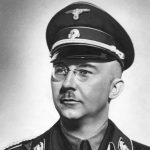 program from his pulpit. Hitler was concerned that other nations would get involved with such publicity about his program. He ordered the program suspended on August 18, 1941…at least in Germany. But 50,000 people had already fallen victim to it.
program from his pulpit. Hitler was concerned that other nations would get involved with such publicity about his program. He ordered the program suspended on August 18, 1941…at least in Germany. But 50,000 people had already fallen victim to it.
Hitler was not to be deterred. He now knew that he had to keep his programs hidden, if he was going to be able to carry out his plans. So, he revived the program in occupied Poland. The people there already had no say in the matter, and he hoped that it would be far enough from Germany so that the German people would not know what was going on. It worked for a time, but in the end, the world would know about the evil he tried so hard to keep hidden, and in the end the number of murder victims was far more than a mere 50,000…it was more like 11 million people.
 Sometimes an evil leader can come in and before anyone realizes it, the danger that came in with him is real. Unfortunately, not every elected leader is a good one, and when an elected leader, begins to do things like taking away the guns of the people and undermining the police, you find out just how bad they really are. Hitler was that kind of elected leader, and worse. By May of 1934, Hitler had been the chancellor of Germany for 16 months, and the dictator for 14 months. Less than a month after Adolf Hitler was appointed chancellor of Germany, he calls on elements of the Nazi party to act as auxiliary police. The SS (Schutzstaffel), initially Hitler’s bodyguards, and the SA (Sturmabteilung, the German Assault Division), who were the street fighters or Storm Troopers of the Nazi party, now operated as the private army of the Nazi party. SS chief Heinrich Himmler also turned the regular (nonparty) police forces into an instrument of terror. He helped forge the powerful Secret State Police (Geheime Staatspolizei), or Gestapo. These non-uniformed police used ruthless and cruel methods throughout Germany to identify and arrest political opponents and others who refused to obey laws and policies of the Nazi regime. It had taken less than a year to change everything for the people of Germany, who no longer had a say in their own lives.
Sometimes an evil leader can come in and before anyone realizes it, the danger that came in with him is real. Unfortunately, not every elected leader is a good one, and when an elected leader, begins to do things like taking away the guns of the people and undermining the police, you find out just how bad they really are. Hitler was that kind of elected leader, and worse. By May of 1934, Hitler had been the chancellor of Germany for 16 months, and the dictator for 14 months. Less than a month after Adolf Hitler was appointed chancellor of Germany, he calls on elements of the Nazi party to act as auxiliary police. The SS (Schutzstaffel), initially Hitler’s bodyguards, and the SA (Sturmabteilung, the German Assault Division), who were the street fighters or Storm Troopers of the Nazi party, now operated as the private army of the Nazi party. SS chief Heinrich Himmler also turned the regular (nonparty) police forces into an instrument of terror. He helped forge the powerful Secret State Police (Geheime Staatspolizei), or Gestapo. These non-uniformed police used ruthless and cruel methods throughout Germany to identify and arrest political opponents and others who refused to obey laws and policies of the Nazi regime. It had taken less than a year to change everything for the people of Germany, who no longer had a say in their own lives.
While he had control, it was still not enough for the insane chancellor. Hitler, as we all know, would go on to annihilate millions of the Jewish people, as well as anyone else he considered an “undesirable” person. While I’m sure the leaders of the German government considered themselves safe, they would find out just how wrong they were on the Night of the Long Knives…also known as a Blood Purge, or putsch in German. By definition, a blood purge is “the elimination en masse by massacre or execution of individuals considered to constitute an untrustworthy or undesirable element within a party or movement. the elimination en masse by massacre or execution of individuals considered to constitute an untrustworthy or undesirable element within a party.” Hitler had decided that some of his own leaders, his trusted associates, could not be trusted. Maybe he was right, but he didn’t really have proof of his doubts. Nevertheless, He decided that there needed to be a blood purge and the Night of the Long Knives was born.
On June 30, 1934, it began, and continued on until July 2, 1934. During the purge of the Night of the Long Knives (Nacht der langen Messer) Hitler and the Nazi regime used the Schutzstaffel (SS) to deal with the perceived problem of Ernst Röhm and his Sturmabteilung (SA) brownshirts (the original Nazi paramilitary organization). The first thing Hitler did was to take out…or defund the police. Believe it or not, that took out the  last protection of the people. He also took out past opponents of the party, thinking that they might organize against them. It is estimated that at least 85 people were murdered, but many historians think that the death toll was likely in the hundreds. Most of those killed were members of the SA, other victims included close associates of Vice Chancellor Franz von Papen, several Reichswehr (German Army) generals…one of whom, Kurt von Schleicher, was formerly the Chancellor of Germany. Hitler also took out their associates. Gregor Strasser, Hitler’s former competitor for control of the Nazi Party was the next to go. At least one person was killed in a case of mistaken identity, sadly, and several innocent victims were simply killed because they “knew too much.” The Night of the Long Knives…was Hitler’s insane revenge on anyone who dared to oppose him, or even to appear to oppose him.
last protection of the people. He also took out past opponents of the party, thinking that they might organize against them. It is estimated that at least 85 people were murdered, but many historians think that the death toll was likely in the hundreds. Most of those killed were members of the SA, other victims included close associates of Vice Chancellor Franz von Papen, several Reichswehr (German Army) generals…one of whom, Kurt von Schleicher, was formerly the Chancellor of Germany. Hitler also took out their associates. Gregor Strasser, Hitler’s former competitor for control of the Nazi Party was the next to go. At least one person was killed in a case of mistaken identity, sadly, and several innocent victims were simply killed because they “knew too much.” The Night of the Long Knives…was Hitler’s insane revenge on anyone who dared to oppose him, or even to appear to oppose him.
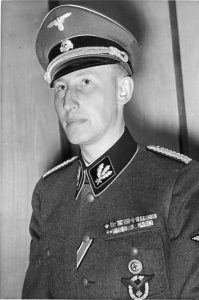 During the evil reign of the Nazi regime, we saw leaders of occupied nations being replaced by a Nazi official, who was in agreement with Hitler on the way things should be run. The deposed leader was then exiled, or worse yet, murdered. In September 1941, Reinhard Heydrich, a high-ranking Nazi official and a primary architect of the holocaust, was named Reich Protector of Bohemia and Moravia (formerly Czechoslovakia). He wasted no time in declaring martial law, and then began executing political prisoners and intelligentsia, and deported the sizable Czech Jewish community. During this time, the Czech government had been exiled to London, but they could not stand what was happening to their countrymen, so they decided to assassinate Heydrich…and so, Operation Anthropoid was born.
During the evil reign of the Nazi regime, we saw leaders of occupied nations being replaced by a Nazi official, who was in agreement with Hitler on the way things should be run. The deposed leader was then exiled, or worse yet, murdered. In September 1941, Reinhard Heydrich, a high-ranking Nazi official and a primary architect of the holocaust, was named Reich Protector of Bohemia and Moravia (formerly Czechoslovakia). He wasted no time in declaring martial law, and then began executing political prisoners and intelligentsia, and deported the sizable Czech Jewish community. During this time, the Czech government had been exiled to London, but they could not stand what was happening to their countrymen, so they decided to assassinate Heydrich…and so, Operation Anthropoid was born.
Two Czech agents, Jan Kubis and Josef Gabcik, had undergone extensive training by British intelligence, and on December 29, 1941, were successfully parachuted into Czechoslovakia. Once on the ground, they had to establish themselves, so they spent six months perfecting a plan with local resistance fighters, who were more 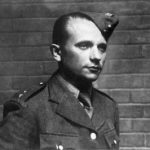
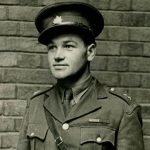 than happy to lend a hand in such an important mission. The plan was perfect. The Reich Protector didn’t think he had anything to fear from the local citizens, whom he assumed were beaten down and obedient. On May 27, 1942, Kubis and Gabcik secretly waited along Heydrich’s usual morning route to the Nazi’s Prague headquarters. Reich Protector Heydrich was an arrogant man, and he boldly rode in an open Mercedes convertible, thinking himself invincible, or at the very least well protected.
than happy to lend a hand in such an important mission. The plan was perfect. The Reich Protector didn’t think he had anything to fear from the local citizens, whom he assumed were beaten down and obedient. On May 27, 1942, Kubis and Gabcik secretly waited along Heydrich’s usual morning route to the Nazi’s Prague headquarters. Reich Protector Heydrich was an arrogant man, and he boldly rode in an open Mercedes convertible, thinking himself invincible, or at the very least well protected.
In an unfortunate turn of events, the machine gun Gabcik pointed at Heydrich, as his vehicle slowed at an L-shaped curve, misfired. Heydrich ordered his driver to stop, planning to shoot Gabcik, but Kubis tossed a 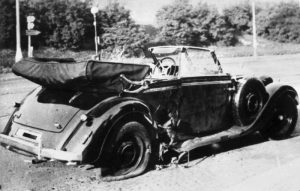 grenade and the Reich Protector’s car, which detonated near the car’s right fender. Both Kubis and Gabcik escaped and Heydrich, who initially thought he was uninjured, died on June 4, 1942. So, in the end the assassination was successful, if not strangely carried out. Unfortunately, not all resistance members are loyal, some can be bought off, and that is what happened in this case. Kubis and Gabcik were betrayed by a resistance member and died heroically, on June 18, 1942, after a gunfight with the Gestapo at a Prague church. While these men ultimately gave their lives for this cause, they were heroes, because the target, Reich Protector Heydrich was assassinated, and that was vital.
grenade and the Reich Protector’s car, which detonated near the car’s right fender. Both Kubis and Gabcik escaped and Heydrich, who initially thought he was uninjured, died on June 4, 1942. So, in the end the assassination was successful, if not strangely carried out. Unfortunately, not all resistance members are loyal, some can be bought off, and that is what happened in this case. Kubis and Gabcik were betrayed by a resistance member and died heroically, on June 18, 1942, after a gunfight with the Gestapo at a Prague church. While these men ultimately gave their lives for this cause, they were heroes, because the target, Reich Protector Heydrich was assassinated, and that was vital.
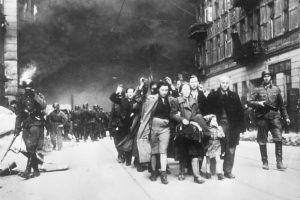 When Hitler began his systematic genocide of the Jewish people during World War II, many of the previously free people found themselves suddenly jailed. They had no weapons with which to fight for their freedom, but they knew that they were going to have to make a decision to either fight for their lives, or lose their lives. Some were too old or too young to fight, and some were women, and many men didn’t think these women could handle the fight at hand, but at some point they would have to fight or die. Hitler was relentless, and the Jewish people were fighting for their lives.
When Hitler began his systematic genocide of the Jewish people during World War II, many of the previously free people found themselves suddenly jailed. They had no weapons with which to fight for their freedom, but they knew that they were going to have to make a decision to either fight for their lives, or lose their lives. Some were too old or too young to fight, and some were women, and many men didn’t think these women could handle the fight at hand, but at some point they would have to fight or die. Hitler was relentless, and the Jewish people were fighting for their lives.
When Hitler set his plan in motion, he made it impossible for them to do business. Overnight, all Jewish businesses were blackballed. That was how it started anyway. The Jewish people were no longer allowed to do business with non-Jews. That action meant that the income that these successful Jewish people had, was instantly taken from them…symbolically. Later, It would be taken in every way. Their shops were looted, their property confiscated, and their homes given to others. As the Jewish people were banished to the ghettos, they had just moments to pack a small bag with the things they could carry, or more importantly the things they couldn’t do without…clothing, any food items, and keepsakes. It wasn’t much. There wasn’t room for much.
The ghettos were complete pits of filth, disease, and humanity. People were piled into cramped quarters, forced to share living quarters with people they didn’t know. Of course, the tight quarters was not the worst thing about the ghettos. The people had no rights. If a Nazi soldier raped, beat, or shot a Jewish person, there was no punishment, because they were no longer considered human, and therefore had no rights. Although it was considered an abomination to sleep with a Jewish person, rape was actually considered just another form of punishment. The Nazis didn’t care. A death meant one less Jew to have to house.
The Warsaw ghetto in Poland occupied an area of less than two square miles but soon held almost 500,000  Jews in the deplorable conditions common to ghettos. Disease and starvation killed thousands every month, and when death did not come fast enough, the Jews were transferred to the next level of their torture. Beginning in July 1942, 6,000 Jews per day were transferred to the Treblinka concentration camp. They went by way of cattle cars, packed so tightly that it was standing room only. In fact, if a prisoner died along the way, their body remained standing…held up by the people so tightly packed in around them.
Jews in the deplorable conditions common to ghettos. Disease and starvation killed thousands every month, and when death did not come fast enough, the Jews were transferred to the next level of their torture. Beginning in July 1942, 6,000 Jews per day were transferred to the Treblinka concentration camp. They went by way of cattle cars, packed so tightly that it was standing room only. In fact, if a prisoner died along the way, their body remained standing…held up by the people so tightly packed in around them.
As word got back to the ghettos that the death rate of those being transferred to the camps, either on the trains, or in the gas chambers when they reached their final destination, the Jewish people knew that something was going to have to be done. They would have to fight for their lives. Of course, the resistance was already working. There were those who saw the writing on the wall from the start. When word came down that the Warsaw ghetto was going to be closed and the Jews deported to the camps, it was time.
On January 18, 1943, as Nazi forces were attempting to clear out the Warsaw ghetto they were met by gunfire from Jewish resistance fighters. Although the Nazis assured the remaining Jews that their relatives and friends were being sent to work camps, they no longer believed the Nazi lies. An underground resistance group had been established in the ghetto, called the Jewish Combat Organization (ZOB). Limited arms had been acquired at great cost, and it didn’t matter, because this was a fight to the death. As the Nazis entered, the ZOB unit ambushed them, killing a number of German soldiers. The fighting lasted for several days.
On January 18, 1943, when the Nazis entered the ghetto to transport a group of Jewish prisoners, a ZOB unit ambushed them. Fighting lasted for several days, and a number of Germans soldiers were killed before they withdrew. On April 19th, Heinrich Himmler announced that the ghetto was to be emptied of its residents in honor of Hitler’s birthday the next day. I guess Himmler thought murdering all those people would make a great birthday gift for Hitler. That day, more than 1,000 SS soldiers entered the confines of the ghetto, armed with tanks and heavy artillery. Of the 60,000 Jews remaining in the ghetto hid in secret bunkers, more than 1,000 of the ZOB resistance members took up arms and fought back with gunfire and homemade bombs. Again the soldiers withdrew, despite only suffering moderate casualties. Then on April 24th, the Germans and launched an all-out attack against the Warsaw Jews.
 The German soldiers stormed through the ghetto, blowing up buildings everywhere. They slaughtered thousands of innocent people. The ZOB took to the sewers to continue the fight. It was cover, but how awful. Then, on May 8th their command bunker fell to the Germans and their resistant leaders committed suicide. I’m sure they thought they had failed their people. By May 16th, the ghetto was firmly under Nazi control, and the last Warsaw Jews were deported to Treblinka. Some 300 German soldiers were killed, and thousands of Warsaw Jews were massacred during the Warsaw Uprising, but that wasn’t the end of the death. Virtually all those who survived the Uprising to reach Treblinka were dead by the end of the war.
The German soldiers stormed through the ghetto, blowing up buildings everywhere. They slaughtered thousands of innocent people. The ZOB took to the sewers to continue the fight. It was cover, but how awful. Then, on May 8th their command bunker fell to the Germans and their resistant leaders committed suicide. I’m sure they thought they had failed their people. By May 16th, the ghetto was firmly under Nazi control, and the last Warsaw Jews were deported to Treblinka. Some 300 German soldiers were killed, and thousands of Warsaw Jews were massacred during the Warsaw Uprising, but that wasn’t the end of the death. Virtually all those who survived the Uprising to reach Treblinka were dead by the end of the war.

